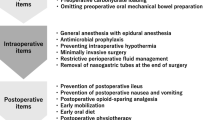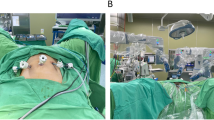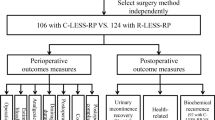Abstract
Laparoscopic radical cystectomy (LRC) is a challenging technique, but it has been proposed as an alternative to open radical cystectomy (ORC), which is currently the gold standard treatment for muscle-invasive or high-risk superficial bladder cancer. So far, approximately 200 cases treated with LRC have been reported in the peer-reviewed literature, but follow-up has generally been short (all <48 months). A shorter hospital stay and a quicker recovery of the patient seem to be the main advantages of LRC over ORC. Functional outcomes, cancer control obtained, and safety of the technique need to be confirmed by studies with larger cohorts of patients and longer follow-up than those previously reported, but an initial analysis suggests that LRC is not equivalent to ORC. Given that the majority of patients selected for LRC had lower American Society of Anesthesiologists scores and lower pathological stages than those in ORC studies, the proportion of patients with orthotopic neobladders (47%) and the proportion of disease-free patients (80%) seem to be suboptimal and, actually, those might represent the major disadvantages of LRC.
Key Points
-
Laparoscopic radical cystectomy (LRC) should be viewed as an experimental surgical procedure, but its main advantages are low blood loss, short associated hospital stay, and quick recovery
-
Cancer control, blood loss and hospital stay are generally similar to those for open radical cystectomy (ORC), but mortality, morbidity and positive surgical margins rates are substantially lower with LRC
-
A possible explanation for the differences in outcomes between LRC and ORC could be that patients in LRC series had lower pathological stage and Americal Society of Anesthetists scores
-
The proportion of patients with orthotopic neobladders and who remain disease free seems to be suboptimal compared with ORC, and might actually represent major disadvantages of LRC
This is a preview of subscription content, access via your institution
Access options
Subscribe to this journal
Receive 12 print issues and online access
$209.00 per year
only $17.42 per issue
Buy this article
- Purchase on Springer Link
- Instant access to full article PDF
Prices may be subject to local taxes which are calculated during checkout
Similar content being viewed by others
References
Parra RO et al. (1992) Laparoscopic cystectomy: initial report on a new treatment for retained bladder. J Urol 148: 1140–1144
Sanchez de Badajoz E et al. (1995) Laparoscopic cystectomy and ileal conduit: case report. J Endourol 9: 59–62
Puppo P et al. (1995) Laparoscopically assisted transvaginal radical cystectomy. Eur Urol 27: 80–84
Gerullis H et al. (2007) Laparoscopic cystectomy with extracorporeal-assisted urinary diversion: experience with 34 patients. Eur Urol 51: 193–198
Abreu SC et al. (2006) Laparoscopic-assisted radical cystectomy with U-shaped orthotopic ileal neobladder constructed using nonabsorbable titanium staples. Urology 68: 193–197
Cathelineau X et al. (2005) Laparoscopic assisted radical cystectomy: the montsouris experience after 84 cases. Eur Urol 47: 780–784
Moinzadeh A et al. (2005) Laparoscopic radical cystectomy in the female. J Urol 173: 1912–1917
Simonato A et al. (2005) Laparoscopic radical cystoprostatectomy: our experience in a consecutive series of 10 patients with a 3 years follow-up. Eur Urol 47: 785–792
Basillote JB et al. (2004) Laparoscopic assisted radical cystectomy with ileal neobladder: a comparison with the open approach. J Urol 172: 489–493
Sorcini A and Tuerk I (2004) Laparoscopic radical cystectomy with ileal conduit urinary diversion. Urol Oncol 22: 149–152
Taylor GD et al. (2004) Hand assisted laparoscopic cystectomy with minilaparotomy ileal conduit: series report and comparison with open cystectomy. J Urol 172: 1291–1296
Menon M et al. (2004) Robot-assisted radical cystectomy and urinary diversion in female patients: technique with preservation of the uterus and vagina. J Am Coll Surg 198: 386–393
Menon M et al. (2003) Nerve-sparing robot-assisted radical cystoprostatectomy and urinary diversion. BJU Int 92: 232–236
Hemal AK et al. (2003) Laparoscopic radical cystectomy and ileal conduit reconstruction: preliminary experience. J Endourol 17: 911–916
Guazzoni G et al. (2003) Laparoscopic nerve- and seminal-sparing cystectomy with orthotopic ileal neobladder: the first three cases. Eur Urol 44: 567–572
Beecken WD et al. (2003) Robotic-assisted laparoscopic radical cystectomy and intra-abdominal formation of an orthotopic ileal neobladder. Eur Urol 44: 337–339
Peterson AC et al. (2002) Laparoscopic hand assisted radical cystectomy with ileal conduit urinary diversion. J Urol 168: 2103–2105
Chiu W et al. (2002) Internal bladder retractor for laparoscopic cystectomy in the female patient. J Urol 168: 1479–1481
Gupta NP et al. (2002) Laparoscopic radical cystectomy with intracorporeal ileal conduit diversion: five cases with a 2-year follow-up. BJU Int 90: 391–396
Abdel-Hakim AM et al. (2002) Laparoscopic radical cystectomy with orthotopic neobladder. J Endourol 16: 377–381
Gill IS et al. (2002) Laparoscopic radical cystectomy and continent orthotopic ileal neobladder performed completely intracorporeally: the initial experience. J Urol 168: 13–18
Turk I et al. (2001) Laparoscopic radical cystectomy with continent urinary diversion (rectal sigmoid pouch) performed completely intracorporeally: the initial 5 cases. J Urol 165: 1863–1866
Gill IS et al. (2000) Laparoscopic radical cystoprostatectomy with ileal conduit performed completely intracorporeally: the initial 2 cases. Urology 56: 26–29
Denewer A et al. (1999) Laparoscopic assisted cystectomy and lymphadenectomy for bladder cancer: initial experience. World J Surg 23: 608–611
Puppo P and Ricciotti G (2001) Videoendoscopically assisted transvaginal radical cystectomy. J Endourol 15: 411–413
Knap MM et al. (2004) Early and late treatment-related morbidity following radical cystectomy. Scand J Urol Nephrol 38: 153–160
International collaboration of trialists (1999) Neoadjuvant cisplatin, methotrexate, and vinblastine chemotherapy for muscle-invasive bladder cancer: a randomised controlled trial. Lancet 354: 533–540
Ghoneim MA et al. (1997) Radical cystectomy for carcinoma of the bladder: critical evaluation of the results in 1,026 cases. J Urol 158: 393–399
Stein JP et al. (2001) Radical cystectomy in the treatment of invasive bladder cancer: long-term results in 1,054 patients. J Clin Oncol 19: 666–675
Novotny V et al. (2007) Perioperative complications of radical cystectomy in a contemporary series. Eur Urol 51: 397–401
Frazier HA et al. (1992) Complications of radical cystectomy and urinary diversion: a retrospective review of 675 cases in 2 decades. J Urol 148: 1401–1405
Herr H et al. (2004) Standardization of radical cystectomy and pelvic lymph node dissection for bladder cancer: a collaborative group report. J Urol 171: 1823–1828
Hautmann RE et al. (2006) Long-term results of standard procedures in urology: the ileal neobladder. World J Urol 24: 305–314
Bassi P et al. (1999) Prognostic factors of outcome after radical cystectomy for bladder cancer: a retrospective study of a homogeneous patient cohort. J Urol 161: 1494–1497
El-Tabey NA and Shoma AM (2005) Port site metastases after robot-assisted laparoscopic radical cystectomy. Urology 66: 1110
Author information
Authors and Affiliations
Corresponding author
Ethics declarations
Competing interests
The authors declare no competing financial interests.
Rights and permissions
About this article
Cite this article
Puppo, P., Introini, C. & Naselli, A. Surgery Insight: advantages and disadvantages of laparoscopic radical cystectomy to treat invasive bladder cancer. Nat Rev Urol 4, 387–394 (2007). https://doi.org/10.1038/ncpuro0840
Received:
Accepted:
Issue Date:
DOI: https://doi.org/10.1038/ncpuro0840



